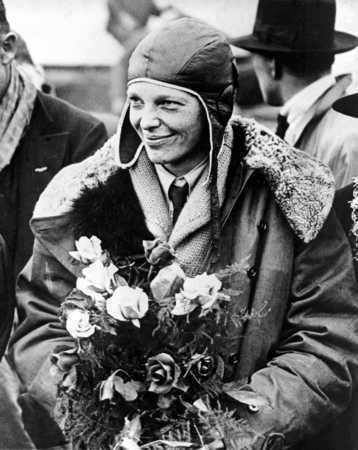
Today in Feminist History is our daily recap of the major milestones and minor advancements that shaped women’s history in the U.S.—from suffrage to Shirley Chisholm and beyond. These posts were written by, and are presented in homage to, our late staff historian and archivist, David Dismore.
May 21, 1932: Amelia Earhart has flown the Atlantic alone!

Leaving from Harbor Grace, Newfoundland, last evening, five years to the day after Lindbergh left on his pioneering flight, she landed safely in a pasture near Culmore, County Londonderry, Northern Ireland, 14 hours and 56 minutes later.
Not only is she the first female pilot to have made the trip by herself, and only the second person to have ever done a solo flight across the North Atlantic, she is the only person to have flown the Atlantic twice in a heavier-than-air craft. The first time, on June 17-18, 1928, she was a passenger on a plane flown by Wilmer Stultz and Louis Gordon. She now holds the record for the fastest transatlantic crossing by any pilot or team of pilots, beating the old record by one hour and sixteen minutes, and has set the record for the longest solo flight by a woman: 2,026 miles.
It was quite a challenging trip, and many an aviator would have turned back and not been criticized for doing so. Despite assurances of good weather, it turned atrocious for five hundred miles during the middle of the flight. Her altimeter gave out after three hours. That piece of equipment was especially crucial, because she had to stay dangerously low to avoid the ice that formed on the wings when she tried flying at high altitudes.
“It was absolutely black,” she said about her hours of flying blind through heavy rain, practically skimming the ocean. The fuel gauge also malfunctioned during the flight. Six hundred miles out she saw flames shooting from the exhaust, and a small amount of fuel dripping from a gas tank. But she still decided to go forward, not turn back. Fortunately, her engine performed perfectly, so that, plus her skill as a pilot, were enough to overcome all the challenges that were thrown her way. After landing she said:
“Ever since my first transatlantic flight in the Friendship, I wanted to do it alone, and I did, even though I had to come down in a pasture outside Londonderry. Until midnight it was smooth sailing for me. The rest of the time – well, you’ve got to expect bad weather out on the Atlantic. I ran into a severe thunderstorm and ice conditions when flying high, so I had to come down pretty quick.
“The gasoline gauge in the cockpit broke and I was getting gas all down the back of my neck. Then the exhaust manifold burned out. Four hours after leaving Newfoundland I saw flames at the exhaust, which worried me. It was a matter of four hours to get back, so I thought I might just as well keep going.”
Telegrams of congratulations are pouring in from all over the world, including one from President Hoover, and Earhart can look forward to a big welcome when she returns home.
Her accomplishment should certainly be a boost to women in aviation, a field they are now entering in increasing numbers. At the beginning of 1929, there were only 34 licensed women pilots in the U.S., whereas there were 512 as of last month. Americans hold six of the seven international women’s flying records.
Earhart set her first women’s record on October 22, 1922, when she went to 14,000 feet. She set a women’s speed record of 181 miles per hour on July 5, 1930, and on April 8th of last year she soared to 18,415 feet in an autogyro, higher than any pilot, man or woman, had ever taken such an aircraft. Today she added more records to her impressive list of achievements, and everyone is looking forward to her next adventure!





